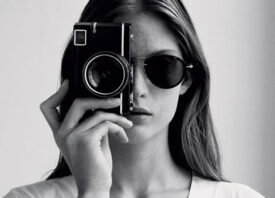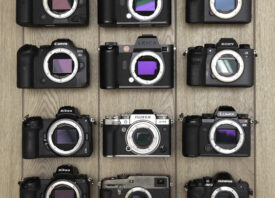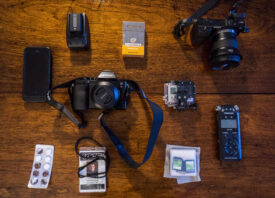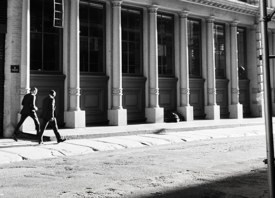Search this site
12 Street Photographers on The Best Leica Camera

What’s the best Leica camera? Turns out, there’s no one-size-fits-all.
A few years ago, Marcin Drozdz attended an Andreas Feininger retrospective exhibition and felt drawn, in particular, to the famous photographs from New York City in the 1940s. He knew he wanted to make pictures like these sometime. Then, while exploring the exhibition, he found a tiny treasure: displayed among the black and white prints themselves was Feininger’s old Leica III camera.
“It was then that I decided that I would buy a Leica camera,” he remembers. “After that, I fell in love with street and documentary photography.” Leica cameras, known for their unobtrusive nature and intuitive design, have been the tool of choice among street photographers for generations. Today, Drozdz owns two Leicas—and one of them is a Leica III, the same camera that inspired him in the very beginning.
“I bought it from an old man in the Netherlands,” he remembers. “He sold it as an exhibition item because the camera was in bad technical condition. It had a broken shutter curtain and was not suitable for photographing. But it’s a Leica, so it was easy to repair at the service. My camera got a complete CLA (clean, lube, and adjust) then a new curtain. To this day, it works reliably, and many years have passed.” It’s so small it fits in his pocket.
We asked ten street photographers to tell us about the best Leica camera they own. Along the way, they shared their experiences, anecdotes, and insights on the time-honored genre.

Leica M6 Classic *film
Ryan Belk: Even though I mainly shoot digital these days, my favorite camera and first Leica is my Leica M6 Classic. I bought it in 2018 before prices went wild like they are now. It came with a Minolta Rokkor 40mm f2 lens for a great price. So it was a great way to make my jump to Leica.
I don’t know its entire story, but the camera was made in 1993, the same year I was born. I bought it from an amazing Polish photographer I want to shout out, Adam Wilkoszarski. Something about the weight and build of it feels like such an incredibly designed tool.
If I’m shooting on the street, there’s no question that a rangefinder camera, built as well as these are, is the perfect tool for the job. I don’t stand in one spot while I’m on the street. I’m constantly moving, and most of my photos are made in passing, so I need the quickness of range focusing in the smallest camera I can get. The Leica M cameras tick all of those boxes.

Ian Wallace: It’s a common answer but for a good reason. I was lucky enough to be an assistant to a film director for some time when I was younger, and I fell in love with the feel of the M6 he owned. Many years later, I was able to save up for my own and got very lucky on an eBay auction for an original boxed M6 from 1989.
There is something about the simplicity of the camera that seems like it has been stripped down and essentialized for street shooters. I don’t like it when the tech gets in the way of the creative, and I feel like the M6 is a perfectly balanced build. There’s extra space in the viewfinder on the edge of the frame, which helps you anticipate a subject entering the frame, and really simple exposure meters, which allow you to just set a range and focus on the shot.

Leica MP *film
Shin Noguchi: Although I use digital Leica for client/assignment work, I use the Leica MP and Summicron 35mm for personal work because I really love the tone of the atmosphere that film has over digital, especially Kodak Portra 400. A digital sensor may be able to record almost every detail in the frame, but I want to value every single time I click the shutter.
I bought both my Leicas used in good condition at Map Camera in Shinjuku, Tokyo, Japan, as always. They are good guys, and I can test the camera until I’m okay with it.
Whenever I go out, whether for a funeral, celebration, or any other reason, I always have my Leica hanging around my neck. I take care of our three daughters (ages thirteen, eight, and five) with my wife, so in between those activities, I spend one to five hours walking around town.
There are probably more days when I don’t press the shutter once. For me, it’s not about ‘making’ pictures. Perhaps the most important thing is to meet someone and enjoy a conversation. I just enjoy the conversation until the urge to record it makes me press the shutter.
I actually ruptured my Achilles tendon while surfing fifteen years ago, and the aftereffect is that walking for an hour causes severe pain in my ankle. But I still have to walk. I can’t just stand here when the possibility of meeting someone is right in front of me.
I’ve had a lot of experiences walking the street. Some people make me angry; others make me smile. They tell me interesting stories that I had never heard before. All these experiences lead to the next encounter and the next click of the shutter. For me, to take a picture is to affirm the existence of people—our human nature and karma—and it’s also an opportunity to affirm my own existence and accept it as it is.

Leica M-P (Typ 240) *digital
John Hendrick: I lived in Washington, DC, when I purchased my first used Leica. At the time, I had grown tired of shooting images and feeling as though the camera was doing all the work. The automatic capabilities of the cameras were terrific, but I often found myself wanting to shoot more creatively and manually.
I took all my equipment to a local shop and offered to sell everything I had. I had two camera bodies, four lenses, a vertical grip, and a flash. Three days later, I was given an offer. I accepted the offer, and I went to the Leica store to see what I could get.
These days, I have discovered a companion that embodies the essence of perfection in photography—the Leica MP240. It’s not about what this camera can do; it’s how it allows me to operate. With its exceptional craftsmanship, intuitive design, and unparalleled image quality, this camera transcends the boundaries of technical excellence and becomes an extension of my creative vision.
By letting go of the automatic features and embracing the manual controls, I can take control of every aspect of the photographic process, which can be rewarding and challenging. At the same time, the true magic of the Leica M240 lies in its ability to produce images of unrivaled quality. This camera captures the subtleties and nuances of light and shadow, enabling me to convey emotions, narratives, and a profound sense of connection with the world around me.

Leica M-A (Typ 127) *film
Michael Luzzio: The Leica M-A is a truly unique camera. It can operate completely devoid of a light meter, batteries, or any other electronic components. This forces the user to learn light and the way it behaves under different circumstances. Through practice, it grants you the ability to read a scene, see exposure, and assign values to create an image that tells the story you are trying to capture.
I purchased this camera brand new from the Leica store in Boston several years ago. I special-ordered the camera to come with the black paint finish, along with an M6 style hinged film advance lever and “zinco” dark-grey leatherette.
I take this camera wherever I go, and its black paint finish reflects this, exhibiting brassing and scratches, a beautiful remnant of the stories it has captured, reminiscent of the Japanese tradition/view of wabi-sabi or the embrace of transience and imperfection.
No batteries to worry about, no viewfinder distractions—just unparalleled reliability. The perfect street photography camera anyone could ask for.

Leica M Monochrom (Typ 246) *digital
Juan Glassford: I bought this camera while driving from New York to Mexico more than a year ago in late June 2022. The M Typ 246 has traveled a lot since.
It came with me to Turkey during the earthquake of February 2023, to the Horn of Africa throughout arduous humanitarian travel near Somalia and Ethiopia, the Rohingya refugee camps of Bangladesh, the Parisian riots against Macron, and the refugee crisis in the US-MEX border. The Typ 246 has managed to outstandingly capture the fluidity of moments despite blinding sandstorms, teargas, and abundant exposure to water, sweat, and scorching heat.
This camera was, until the recent release of the M11 Monochrom, the modern embodiment of classic Leica cameras. For street photographers who wish to shoot digital with the feel of analog and that can’t afford the new M11, this is your best bet.
This is a challenging camera for challenging situations. You need to know and understand your camera as deeply as possible; your understanding of the equipment has to become as smooth as walking and breathing. Once you do this, the camera disappears as an instrument and becomes an extension of who you are.

Leica Q (Typ 116) *digital
Matthew Steaffens: Currently, I own two Leicas, but if I’m hitting the streets, the Q is my go-to. I think as young photographers, we all hear stories of this mythical camera that is a Leica, but few understand it until they actually use it. The Q isn’t magical, and to be honest, it doesn’t do anything that just about any modern camera can’t.
In fact, the Q has far fewer bells and whistles than most cameras on the market. That is what makes it great. It gives you everything you need, while leaving the clutter and shiny functions behind. It forces you into the moment.
Beyond the best user experience from any camera I’ve used, one of my favorite features is the leaf shutter, which, beyond its many advantages, allows me to move into a moment, and not have a slap of a shutter that gives the moment pause. It is a camera that truly connects the eye and hand.

Leica Q2 *digital
Chris Harrison: I started using Leica cameras after attending a Bruce Gilden workshop at the Leica Store in Mayfair, London. These days, I use two Leica cameras, but I use my pre-owned Q2 with the fixed 28mm lens most of the time.
It’s not in mint condition anymore—far from it—it’s very well used, and it shows. But cameras are meant to be used, and my Q2 has been battered by rain and salty sea air down on Brighton seafront many, many times. It can take a real hammering, without any loss to image quality or mechanical functionality.
Apart from that, it’s just very well-designed, and I find it really intuitive to use. It’s fast and responsive, and it’s not big and bulky, so you can carry it around comfortably for several hours, and it doesn’t feel like a cumbersome load.

Leica M11 *digital
Robin Sinha: Although I love almost everything about my M6, I’m more of a digital shooter these days and would have to say the Leica M11 is my current favourite camera. It still has the classic M rangefinder experience, but it’s simultaneously packed with the latest technology that further simplifies many processes.
M cameras, in general, have a small form factor and classic, discrete appearance. Additionally, zone focusing takes focusing out of the equation, and when combined with a full manual exposure, everything can be pre-set for your shooting environment.
This means you can concentrate solely on the subject matter, compositional elements, and your distance to the subject. It’s genuinely a freeing, addictive experience that allows you to get very close while remaining somewhat unseen.

Eric Davidove: I use this camera with a 35mm prime lens. It’s light with a small form factor (helping me to blend in and get less noticed) and has the ability to use a variety of different lenses.
I mostly enjoy the zone focusing capability, rangefinder experience, simple and intuitive menu system, the internal hard drive in addition to a card slot, and the very long battery life. Bottom line: This camera provides a “film-like” experience with digital benefits, which helps me focus more on composing photos rather than on operating the camera.

Daniel Hedquist: My favorite would be the Leica M11 and usually with the Leica M Summilux 35mm f1.4. I bought a Leica M4 first and really liked to shoot with that camera. So when I wanted something similar but for digital photography, I went with the M11.
It works really well for street photography with its small size and quiet shutter. I also like the M11 a lot because of the sensor and low-light capabilities. I live in Stockholm, Sweden, so the winters are really dark. It makes me want to go out and take pictures. It inspires me. For me, that’s the most important thing about a camera.

Leica Q3 *digital
Tommaso Carrara: This camera has all the essential features and, at the same time, sports crazy power. Not that you need them all the time: to be honest, the over 60MP resolution, the IBIS, the tilt screen, and so on are really not needed for street. That said, I use the Leica Q3 for a little bit of everything: travel photography, pet photography, a day out, and in general to document whatever surrounds me. This is why the aforementioned characteristics are a nice add-on, to make this camera a great all rounder.
The more often you use it, the better you become as a photographer. Other than the technicalities, I love this camera because it is so compact and sturdy, I do not have to worry too much nor do I need to babysit it. Also, the usb-c charging is so convenient, you are pretty much covered everywhere. This camera, like any other, is made to be used, and oh boy, what a beautiful experience it is.
Trying your first Leica…
“Today, many companies offer rental capabilities that will allow you to test out the rangefinder form of picture-making and see if you are genuinely drawn to it,” John Hendrick explains. “Considering the huffy price tag associated with these cameras, it would be a pain to purchase one only not to like the shooting experience.
“After you have purchased one, the best tip I can offer is to embrace the only dials you need right at your fingertips, isolate your subject with the aperture ring, and freeze or create motion with your shutter speed. The rest is capturing moments.”
Further reading:
• These Nostalgic Photos Capture the Spirit of NYC
• Atmospheric Street Photography with an Abstract Twist
• Decades of Extraordinary Photos Taken on the Streets of NYC



